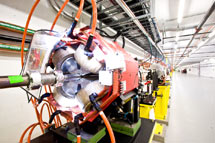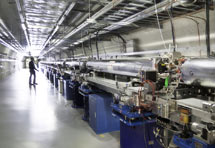
Handy Links
SLAC News Center
SLAC Today
- Subscribe
- Archives: Feb 2006-May 20, 2011
- Archives: May 23, 2011 and later
- Submit Feedback or Story Ideas
- About SLAC Today
SLAC News
Lab News
- Interactions
- Lightsources.org
- ILC NewsLine
- Int'l Science Grid This Week
- Fermilab Today
- Berkeley Lab News
- @brookhaven TODAY
- DOE Pulse
- CERN Courier
- DESY inForm
- US / LHC
SLAC Links
- Emergency
- Safety
- Policy Repository
- Site Entry Form

- Site Maps
- M & O Review
- Computing Status & Calendar
- SLAC Colloquium
- SLACspeak
- SLACspace
- SLAC Logo
- Café Menu
- Flea Market
- Web E-mail
- Marguerite Shuttle
- Discount Commuter Passes
-
Award Reporting Form
- SPIRES
- SciDoc
- Activity Groups
- Library
Stanford
Around the Bay
Welcome to the LCLS Generation
A short but detailed technical introduction to the Linac Coherent Light Source appeared online Sunday in Nature Photonics. Coordinated by Paul Emma, head of the LCLS accelerator physics group and with contributions from many of his LCLS teammates, the paper is a virtual tour of the LCLS in six pages plus references and acknowledgements.
"We thought the LCLS really deserved a high-visibility, refereed publication to communicate its capabilities and for a clear reference to similar efforts elsewhere," Emma said. "Surprisingly, the article was started in November of 2009 and took some patience to pursue, but we are very happy to see it finally finished."
The long-awaited "tour" ranges from linac modifications to user facilities, with several stops along the way: the new injector that shoots precisely-shaped pulses of high-energy electrons into the linac; two new magnetic bunch compressors that squeeze each bunch of electrons into a smaller package with a bigger punch; the Beam Transport Hall that delivers high-energy electrons to the Undulator Hall; the undulator magnets that induce the electrons to emit X-rays; the diagnostics that verify beam quality; and finally, the optics that send the X-rays on their way to the experimental hutches.
"LCLS presents unique problems for X-ray optics," according to John Arthur, who oversaw the development of the LCLS X-ray beamline. "We were forced to push the state of the art.”
Like a good tour guide, the paper includes some fascinating tidbits. For example, the average amount of power contained in the X-ray beam is so low that the equipment doesn't even get hot, but the power packed into each separate X-ray pulse is so great (up to 40 gigawatts) that exposed surfaces can suffer local damage. Boron carbide, with its high melting point and poor absorption of X-rays, was chosen as a protective coating, to diffuse the power over a large volume and maintain manageable local stress levels.
The paper also addresses some big questions, such as "Why?" The answer proves quite simple. Previous X-ray sources such as the Stanford Synchrotron Radiation Lightsource are extremely valuable for probing the structures of materials at the atomic level, but to really "see" individual molecules and atoms move—to follow interactions of materials on such a minute level—a new generation of lightsource was needed. The LCLS is the first member of that new generation.
And the paper serves as a culmination of sorts to years of inspired design work, meticulous planning and tireless attention to detail and safety, including major contributions from Lawrence Livermore National Laboratory related to the X-ray optics and diagnostics systems, and from Argonne National Laboratory with the undulator systems design and fabrication.
SLACers, their Stanford colleagues, and laboratory stakeholders will celebrate those years of effort, persistence, imagination and occasionally sheer stubbornness on the afternoon of August 16, during the LCLS dedication.
The paper in Nature Photonics tells the technical and scientific community, "This is the LCLS and here is what it can do." The dedication will tell everyone, "This is the LCLS. This is what we can do."
—Lori Ann White
SLAC Today, August 2, 2010

